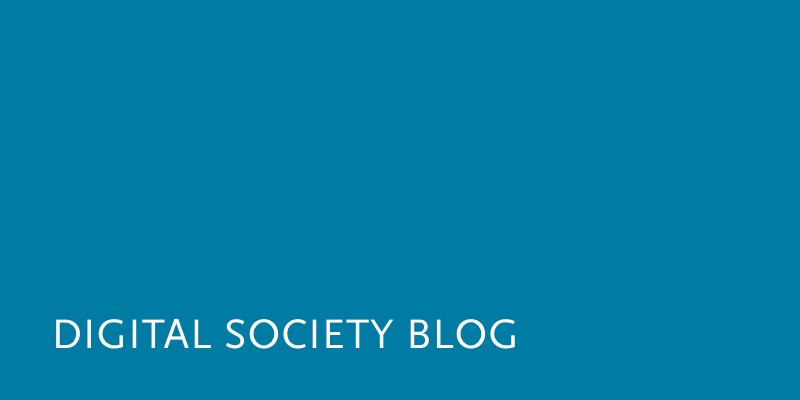Unsere vernetzte Welt verstehen

Blockchain-Technologie: Von Eintreten für die Privatsphäre bis Supply Chains
Ursprünglich erdacht, um kryptografische Währungen wie Bitcoin zu ermöglichen, die eine zentrale Abwicklungsstelle nicht benötigen, ist die sogenannte Blockchain-Technologie inzwischen über diesen Anwendungsbereich hinausgewachsen und zu einem Phänomen geworden, dem unterschiedliche Gruppen wie Hacktivisten aber auch Startup-Gründer und Unternehmer Aufmerksamkeit schenken. Welche Gemeinsamkeiten und Motivationen haben diese Gruppen und wo kann die Blockchain-Technologie neben kryptografischen Währungen noch angewendet werden?Wir hatten das Vergnügen, mit Zaki Manian zu sprechen, Gründer des Startups Skuchain. Skuchain wendet Blockchain-Technologie auf die Verwaltung von internationalen Lieferketten an. Dafür entwickelt es eine Lösung namens Brackets, welche den Handelspartnern eine bessere Kommunikation und Abstimmung ermöglichen soll. Gleichzeitig ist Zaki aber auch Aktivist für Kryptographie und Privatsphäre. Er engagiert sich in Open-Source-Projekten rund um mehr Sicherheit und ist aktiv in Restore the Fourth, einer NGO in den USA, welche sich gegen staatliche Überwachung richtet. Wir haben mit Zaki über Brackets gesprochen und inwiefern er Verbindungen in seiner Rolle als Startup-Gründer und Aktivist sieht. Im Folgenden fassen wir die wesentlichen Aspekte zusammen und skizzieren die Zusammenhänge, die Zaki zwischen diesen sieht.
Blockchain and Supply Chain Management
There is a big hype surrounding blockchain technology and its positive effect on reducing transaction costs as well as bringing about cooperation and commitment between the parties. How does such technology differ, for example, from traditional Electronic Data Exchange and e-invoicing platforms?
Facilitating supply chain transactions is one of the applications of Blockchain in non-cryptocurrency matters. Zaki believes that Blockchain can give the trading parties certain independence from various intermediaries. It gives multiple parties the power to monitor transactions and if any third party is involved, it cannot have access to sensitive information. In a traditional supply chain, Letter Credit is used as a payment to secure commitment and cooperation and involves various banks and other institutions. It is the most efficient mechanism at the moment compared to other methods, but it is still time consuming. Using Blockchain technology instead of the traditional methods of handling documents for Letters of Credit facilitates the handling of the documents in one consistent ledger among all the parties involved in the supply chain. It allows the parties to selectively share information with each other. Using Blockchain as a shared source of truth reduces the costs of going back and forth between multiple parties to confirm and correct information. Blockchain also helps with the financiers.
This might all sound similar to traditional e-invoicing and Electronic Data Interchange. So how is a blockchain-based system better than traditional e-invoicing and networks?
The answer does not lie within efficiency only. Blockchain can help protecting business privacy and business secrets from intermediaries. In traditional electronic data exchanges, the intermediary has access to information that can be commercialized and can affect the price of the goods and merchandise that the supplier provides. The intermediary is involved with and has control of the entire transaction from beginning to end. As a result, there is a huge potential for misuse and trust issues. Blockchain technology, on the other hand, provides the supplier and the buyer with an independent software that can facilitate transactions and allows different companies that do not tend to trust each other to directly collaborate, facilitating what Zaki describes as collaborative commerce. Blockchain might not be the only answer to facilitating supply chain transaction, but it could be more efficient than the solutions commonly used today and might gain more attraction. Zaki hopes that a broad adoption of Brackets would not only make supply chains more efficient – it should also bring about a policy change on the long run.
Aligning the interests of business and counter-surveillance advocacy
For Zaki, Skuchain is not just an attempt to apply Blockchain technology to domains outside of cryptocurrency. It is also part of an effort to align the interests of business with the counter-surveillance advocacy he is engaged in. Privacy advocates and security engineers who develop applications that offer strong encryption by default and are easy to use, like Signal, face a fundamental issue: It is relatively easy for governments to circumvent, undermine, or even ban technology that is meant to shield citizens from mass surveillance. With Blockchain technology, Zaki is ultimately trying to achieve similar goals (strong cryptography and an end of mass surveillance programs) with different means. Companies like Skuchain are opening up an “entirely separate frontier of applied cryptography”: Using cryptography to manage business relationships rather than security relationships.
If your fundamental business relationships, if your economy itself is resting on the basis of strong cryptography…it becomes almost impossible for the governments of the world to not embrace that technology. (Zaki Manian)
Supporting a wide use of secure Blockchain applications like Brackets to manage business relationships would help making strong cryptography indispensable for companies and give them an incentive to start lobbying against backdoors, which Zaki thinks is far more effective and sustainable than only arguing from a human rights perspective. For him, this is the “moral upside of the work” at Skuchain.
The idea that businesses and nonprofit groups overlap and align to some extent in their goals and ambitions is unsurprising: the Blockchain technology itself was built to implement certain ideas about how economy and society at large should be organized. Dividing the larger ‘Blockchain community’ along the lines of for-profit and non-profit is difficult. For Zaki, much more apparent is the dispute over decentralization that across for-profit and nonprofit groups.
Decentralization and trust
For Zaki, the matter of decentralization is one of the important green lines marking diverging interests within the blockchain community. Within this community, he sees a strong notion of blockchain as one of the technologies to break corporate and government control over the internet. Deploying decentralized systems which can offer the same services to people serves as the main method to pursue this goal. On the other hand, as Zaki observes it, there is a group who follows a more functional approach when purporting blockchain as a solution. For them, blockchain offers a distinct set of properties of for example privacy, security and resilience, partly due to being decentralized.
Decentralization has been an ever prominent prospect of blockchain-facilitated applications: the notion of overcoming intermediaries who create trust among all sorts of relationships. Ditching those intermediaries out of the loop would not only increase the efficiency of transactions along these relationships (and thus reducing transaction costs), but also reduce the dependence of the two endpoints of a transaction on a third party, whose policies typically shape the formation of the transaction in question. As exemplified in detail before, these questions became especially prevalent in multi-party scenarios like international trade and finance, where supply chains do not only meet different legislations but also rest upon institutions of trust dating back up to a few hundred years like the Letter of Credit. These institutions serve as well-established means to mitigate risks of remote and mediated transactions by delicately recording and arranging small steps of the performance on the agreement.
Here, blockchain-facilitated applications oftentimes advertise to provide so called “trustless systems” (or ledgers), which rest upon decentralized design. This design is promised to weed out single points of failure (or, in this context, single points of trust) and thus enhancing the independence of the transactional parties. However, one might question whether the notion of decentralization is really as well-defined as it might seem. Only recently, Mathew pointed out that “if the internet encapsulated certain freedoms in the past, it was by no means as a consequence of intrinsically decentralized technology” (Mathew, 2016). Similar to the design of the internet protocol, a blockchain protocol enables all participants to equally emerge in both roles: as claimant of an asset to be transferred and as judge to verify the claims of all other participants. Commodities like trust, which are conceptually centralized as a resource of cooperation for multiple parties, hence rest on shared production facilities. What we see is a shift of roles: the same people who use this commodity are the ones who produce it. The issue itself (how do we trust the producer?) reappears as an issue of trust in the mechanisms organizing this distributed process.
We see that the meaning of decentralization is a changing one, depending on the problems one tries to solve with Blockchain. However, the interview with Zaki showed us that Blockchains are not only about decentralization and efficiency, but also relate to a much broader cultural change towards collaborative commerce and a sort of privacy advocacy that manages to align with commercial interests while still opposition forms of surveillance capitalism.
This is an article by Farzaneh Badiei, Julian Hölzel and Stefan Baack.
Dieser Beitrag spiegelt die Meinung der Autorinnen und Autoren und weder notwendigerweise noch ausschließlich die Meinung des Institutes wider. Für mehr Informationen zu den Inhalten dieser Beiträge und den assoziierten Forschungsprojekten kontaktieren Sie bitte info@hiig.de
Forschungsthemen im Fokus
Digitale Zukunft der Arbeitswelt
HIIG Monthly Digest
Jetzt anmelden und die neuesten Blogartikel gesammelt per Newsletter erhalten.
Digitalisierung erkunden: Indigene Perspektiven aus Puno, Peru
Was sind indigene Perspektiven der Digitalisierung? Die Quechuas in Peru zeigen Offenheit für die Anforderungen an das Wachstum ihrer digitalen Wirtschaft.
Diamond OA: Für eine bunte, digitale Publikationslandschaft
Der Blogpost macht auf neue finanzielle Fallstricke in der Open-Access-Transformation aufmerksam und schlägt eine gemeinschaftliche Finanzierungsstruktur für Diamond OA in Deutschland vor.
Desinformation: Überschätzen wir uns wirklich selbst?
Wie bewusst sind wir im Umgang mit Desinformation im Internet und vermittelt der öffentliche Diskurs ein ausgewogenes Bild der Reichweite von Desinformationen?







